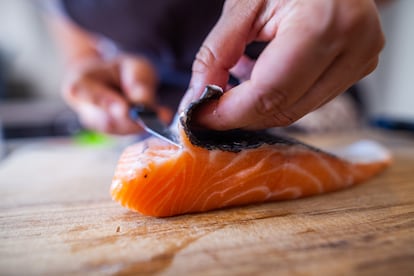Out with sugary cereal, in with salmon: The US proposes a new definition of healthy food
The FDA has produced updated guidelines regarding acceptable amounts of saturated fat, sodium and added sugar content in packaged products

The US Food and Drug Administration (FDA) is proposing a new definition of what constitutes healthy food. The new definition will apply to information that appears on nutrition labels for packaged food. From now on salmon and avocados are considered healthy foods, which they were not until now due to their high fat content. Breakfast cereal with added sugars that were once considered healthy will no longer fit the bill.
“More than 80% of people in the US aren’t eating enough vegetables, fruit and dairy. And most people consume too much added sugars, saturated fat and sodium,” said the FDA in a statement. “The proposed rule is part of the agency’s ongoing commitment to helping consumers improve nutrition and dietary patterns to help reduce the burden of chronic disease and advance health equity.”
The FDA has announced that it is developing a graphic symbol that manufacturers of processed food can use to show that their product meets the “healthy” claim criteria. The new nutritional label must now be on the front of the packaging and not on the back or side. The White House has announced that the new nutritional system proposed by the FDA will be communicated through symbols that are easily identifiable by consumers such as “a star rating or a traffic light system.”
The new nutritional information system contemplates two aspects: foods classifed as healthy must contain a “significant” amount of nutrients from at least one of the groups or subgroups recommended by the food guidelines, such as vitamins, calcium, iron, protein or dietary fiber. In addition, they must comply with the required limits for saturated fats, sodium (salt) and added sugars. Maira Bes Rastrollo, a professor of medicine and public health at the University of Navarre in Spain, described this update as “a step forward.” “It is a very favorable point that added sugars have been included, something that Nutri-Score, the system we have in Spain, does not do.”
In EU member states, nutritional information has been mandatory in packaged food since 2011 and this information must include the list of ingredients and the nutritional information table. But the European Commission also admitted that not everyone may understand the labeling, and proposed a voluntary system to add information on the front of the product.
The new US system also takes into account the type of food when establishing nutritional limits, which makes it better than Spain’s Nutri-Score: “Olive oil, which is 100% fat, had a very bad score. Under the US proposal, the maximum fat limit depends on the type of food being considered. That allows you to adapt much better,” noted Bes Rastrollo.
According to data provided by the FDA, in 2019 42% of teens and 39% of adults said they ate fruit less than once a day, while 41% of teens and 21% of adults said they ate vegetables less than once a day. And that is what the American government wants to change. “The step they have taken is positive because there is evidence that correct nutritional information helps change purchasing habits,” said Bes Rastrollo. “But I think that rather than information about what is healthy, consumers need information about what is not, as they do, for example, in Chile.” In that South American country, nutritional information about packaged food is based on four seals that foods that exceed the established healthy limits must carry: high in sugars, high in saturated fats, high in sodium, high in calories.
The FDA released its first definition of healthy food in 1994, but dietary guidelines have since changed along with advances in nutritional research. In 2016, the agency began a process to update what is considered healthy food that is now coming to its final stages. But the process was paused during the presidency of Donald Trump, as the committee in charge of setting the country’s food guidelines was prohibited from considering the health effects of red meat, salt and ultra-processed foods. The Biden administration, by contrast, has encouraged the endeavor.
Tu suscripción se está usando en otro dispositivo
¿Quieres añadir otro usuario a tu suscripción?
Si continúas leyendo en este dispositivo, no se podrá leer en el otro.
FlechaTu suscripción se está usando en otro dispositivo y solo puedes acceder a EL PAÍS desde un dispositivo a la vez.
Si quieres compartir tu cuenta, cambia tu suscripción a la modalidad Premium, así podrás añadir otro usuario. Cada uno accederá con su propia cuenta de email, lo que os permitirá personalizar vuestra experiencia en EL PAÍS.
¿Tienes una suscripción de empresa? Accede aquí para contratar más cuentas.
En el caso de no saber quién está usando tu cuenta, te recomendamos cambiar tu contraseña aquí.
Si decides continuar compartiendo tu cuenta, este mensaje se mostrará en tu dispositivo y en el de la otra persona que está usando tu cuenta de forma indefinida, afectando a tu experiencia de lectura. Puedes consultar aquí los términos y condiciones de la suscripción digital.
More information
Archived In
Últimas noticias
Most viewed
- Sinaloa Cartel war is taking its toll on Los Chapitos
- Oona Chaplin: ‘I told James Cameron that I was living in a treehouse and starting a permaculture project with a friend’
- Reinhard Genzel, Nobel laureate in physics: ‘One-minute videos will never give you the truth’
- Why the price of coffee has skyrocketed: from Brazilian plantations to specialty coffee houses
- Silver prices are going crazy: This is what’s fueling the rally











































